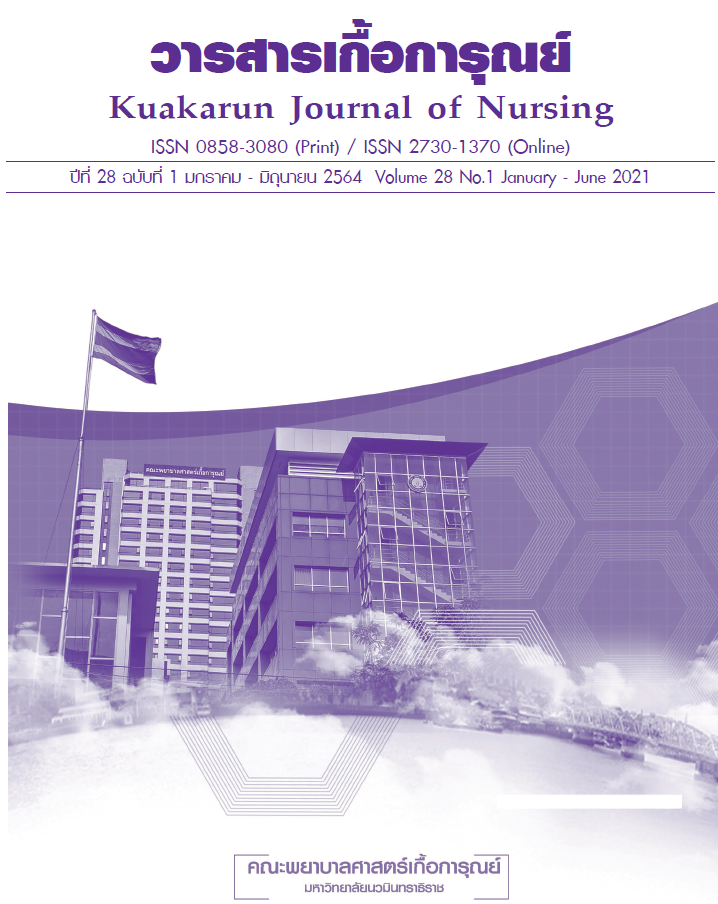ปัจจัยทำนายความตั้งใจในการฉีดวัคซีนป้องกันเชื้อเอชพีวีในชายรักชายที่มารับบริการสุขภาพทางเพศ
คำสำคัญ:
ความตั้งใจในการฉีดวัคซีนป้องกันเชื้อเอชพีวี, มะเร็งปากทวารหนัก, ชายรักชายบทคัดย่อ
การวิจัยแบบบรรยายเชิงทำนายนี้ มีวัตถุประสงค์เพื่อศึกษาปัจจัยทำนายความตั้งใจในการฉีดวัคซีนป้องกันเชื้อเอชพีวีในชายรักชายที่มารับบริการสุขภาพทางเพศ ประกอบด้วย 5 ปัจจัยคือ ความรู้เกี่ยวกับ เชื้อเอชพีวี ความคาดหวังผลลัพธ์การฉีดวัคซีนป้องกันเชื้อเอชพีวี การควบคุมตนเองในการฉีดวัคซีนป้องกันเชื้อเอชพีวี การรับรู้สถานการณ์การฉีดวัคซีนป้องกันเชื้อเอชพีวี และการรับรู้ความสามารถของตนเอง ในการฉีดวัคซีนป้องกันเชื้อเอชพีวี กลุ่มตัวอย่างคือ ชายรักชายที่มารับบริการสุขภาพทางเพศ ณ สถานบริการสุขภาพ จำนวน 140 คน อายุ 18 - 40 ปี คัดเลือกกลุ่มตัวอย่างแบบตามสะดวก เครื่องมือที่ใช้ในการรวบรวมข้อมูล คือ แบบวัดความรู้เกี่ยวกับเชื้อเอชพีวี แบบสอบถามความคาดหวังผลลัพธ์การฉีดวัคซีนป้องกันเชื้อเอชพีวี แบบสอบถามการควบคุมตนเองในการฉีดวัคซีนป้องกันเชื้อเอชพีวี แบบสอบถามการรับรู้สถานการณ์การฉีดวัคซีนป้องกันเชื้อเอชพีวี แบบสอบถามการรับรู้ความสามารถของตนเองในการฉีดวัคซีนป้องกันเชื้อเอชพีวี และแบบสอบถามความตั้งใจในการฉีดวัคซีนป้องกันเชื้อเอชพีวี ได้รับการตรวจสอบ ความตรงเชิงเนื้อหาจากผู้ทรงคุณวุฒิ จำนวน 5 ท่าน มีค่าดัชนีความตรงเท่ากับ 1.00, .87, 1.00, 1.00, 1.00 และ 1.00 ตามลำดับ และมีค่าสัมประสิทธิ์ KR - 20 และครอนบาคแอลฟา เท่ากับ .82, .81, .81, .94, .94 และ .90 ตามลำดับ วิเคราะห์ปัจจัยทำนายด้วยสถิติถดถอยพหุคูณแบบขั้นตอน
ผลการศึกษา พบว่า 1) ชายรักชายที่มารับบริการสุขภาพทางเพศ มีค่าเฉลี่ยคะแนนความตั้งใจ ในการฉีดวัคซีนป้องกันเชื้อเอชพีวี อยู่ในระดับสูง ( = 11.39, S.D = 2.39) 2) ปัจจัยการรับรู้ความสามารถของตนเองในการฉีดวัคซีนป้องกันเชื้อเอชพีวี (β = .41) การรับรู้สถานการณ์การฉีดวัคซีนป้องกันเชื้อเอชพีวี (β = .23) และความรู้เกี่ยวกับเชื้อเอชพีวี (β = .14) สามารถร่วมทำนายความตั้งใจในการฉีดวัคซีนป้องกันเชื้อเอชพีวีของชายรักชายที่มารับบริการสุขภาพทางเพศได้ ร้อยละ 40.10 อย่างมีนัยสำคัญทางสถิติที่ระดับ .05 อย่างไรก็ตาม ผลการศึกษาพบว่า ปัจจัยความคาดหวังผลลัพธ์การฉีดวัคซีนป้องกันเชื้อเอชพีวี และการควบคุมตนเองในการฉีดวัคซีนป้องกันเชื้อเอชพีวีไม่สามารถทำนายความตั้งใจในการฉีดวัคซีนป้องกันเชื้อเอชพีวีในชายรักชายที่มารับบริการสุขภาพทางเพศได้ (p-value > .05) ผลการวิจัยในครั้งนี้จะเป็นประโยชน์ในการส่งเสริมความตั้งใจในการฉีดวัคซีนป้องกันเชื้อเอชพีวีให้กับชายรักชายเพื่อลดอุบัติการณ์ของมะเร็งปากทวารหนัก
เอกสารอ้างอิง
Siegel RL, Miller KD, Jemal A. Cancer statistics, 2018. CA: A Cancer Journal for Clinicians 2018;68(1):7-30.
Viens LJ, Henley JS, Watson M, Markowitz LE, Thomas CC, Thompson TD, et al. Human papillomavirus - associated cancers - United States, 2008–2012. Morbidity and Mortality Weekly Report 2016;65(26):61-6.
Saraiya M, Unger ER, Thompson TD, Lynch CF, Hernandez BY, Lyu CW, et al. US assessment of HPV types in cancers: implications for current and 9-valent HPV vaccines. Journal of the National Cancer Institute 2015;107(6):1-12.
Park IU, Introcaso C, Dunne EF. Human papillomavirus and genital warts: a review of the evidence for the 2015 centers for disease control and prevention sexually transmitted diseases treatment guidelines. Clinical Infectious Diseases 2015;61(8):849-55.
Machalek DA, Poynten M, Jin F, Fairley CK, Farnsworth A, Garland SM, et al. Anal human papillomavirus infection and associated neoplastic lesions in men who have sex with men: a systematic review and meta-analysis. The Lancet Oncology 2012;13(5):487-500.
Petrosky E, Bocchini JA Jr, Hariri S, Chesson H, Curtis CR, Saraiya M, et al. Use of 9-valent human papillomavirus (HPV) vaccine: updated HPV vaccination recommendations of the advisory committee on immunization practices. Morbidity and Mortality Weekly Report 2015;64(11):300-4.
Giuliano AR, Palefsky JM, Goldstone S, Moreira ED Jr, Penny ME, Aranda C, et al. Efficacy of quadrivalent HPV vaccine against HPV Infection and disease in males. The New England Journal of Medicine 2011;364(5):401-11.
Phanuphak N, Teeratakulpisarn N, Pankam T, Kerr SJ, Barisri J, Deesua A, et al. Anal human papillomavirus infection among Thai men who have sex with men with and without HIV infection: prevalence, incidence, and persistence. Journal of Acquired Immune Deficiency Syndromes 2013;63(4):472-9.
Goldstone S, Palefsky JM, Giuliano AR, Moreira ED Jr, Aranda C, Jessen H, et al. Prevalence of and risk factors for human papillomavirus (HPV) infection among HIV-seronegative men who have sex with men. Journal of Infectious Diseases 2011;203(1):66-74.
U.S. Food and Drug Administration. October 16, 2009 approval letter-gardasil [Internet]. 2009 [cited 2018 May 9]. Available from: http://wayback.archive-it.org/7993/20170722145332/https://www.fda.gov/BiologicsBloodVaccines/Vaccines/ApprovedProducts/ucm186991.htm
Thailand Food and Drug Administration. July 22, 2014 approval human papilloma virus GARDASIL registration No. 1C11/55(NB) [Internet]. 2014 [cited 2018 May 9]. Available from:
Wheldon CW, Daley EM, Buhi ER, Nyitray AG, Giuliano AR. Health beliefs and attitudes associated with HPV vaccine intention among young gay and bisexual men in the southeastern United States. Vaccine 2011;29(45):8060-5.
Priest HM, Knowlden AP, Sharma M. Social cognitive theory predictors of human papillomavirus vaccination intentions of college men at a southeastern university. International Quarterly of Community Health Education 2015;35(4):371-85.
Bandura A. Health promotion by social cognitive means. Health Education and Behavior 2004;31(2):143-64.
Fishbein M, Ajzen I. Predicting and changing behavior: the reasoned action approach. New York: Taylor & Francis; 2011.
Meites E, Szilagyi PG, Chesson HW, Unger ER, Romero JR, Markowitz LE. Human papillomavirus vaccination for adults: updated recommendations of the Advisory Committee on Immunization Practices. American Journal of Transplantation 2019;19(11):3202-6.
Public Health England. HPV vaccination pilot for men who have sex with men: clinical and operational guidance for healthcare professionals [Internet]. 2016 [cited 2019 Feb 20]. Available from: https://assets.publishing.service.gov.uk/government/uploads/system/uploads/attachment_data/file/697362/HPV_MSM_clinical_and_operational_guidance.pdf
Cohen J. Statistical power analysis for the behavioral sciences. New Jersey: Lawrence Erlbaum Associates; 1988.
van Keulen HM, Otten W, Ruiter RA, Fekkes M, van Steenbergen J, Dusseldorp E, et al. Determinants of HPV vaccination intentions among Dutch girls and their mothers: a cross- sectional study. BMC Public Health 2013;13:1-21.
Sharma M, Nahar VK. New approach for promoting HPV vaccination in college men based on multi-theory model (MTM) of health behavior change. Journal of Preventive Medicine and Hygiene 2017;58(3):203-10.
Kreupimy S, Thato R. Factors predicting intention to take human papillomavirus vaccine among men who have sex with men students. Kuakarun Journal of Nursing 2016;23(1):102-17. (in Thai)
Marra E, Alberts C, Zimet GD, Paulussen T, Heijman T, Hogewoning A, et al. HPV vaccination intention among male clients of a large STI outpatient clinic in Amsterdam, the Netherlands. Papillomavirus Research 2016;2:178-84.















